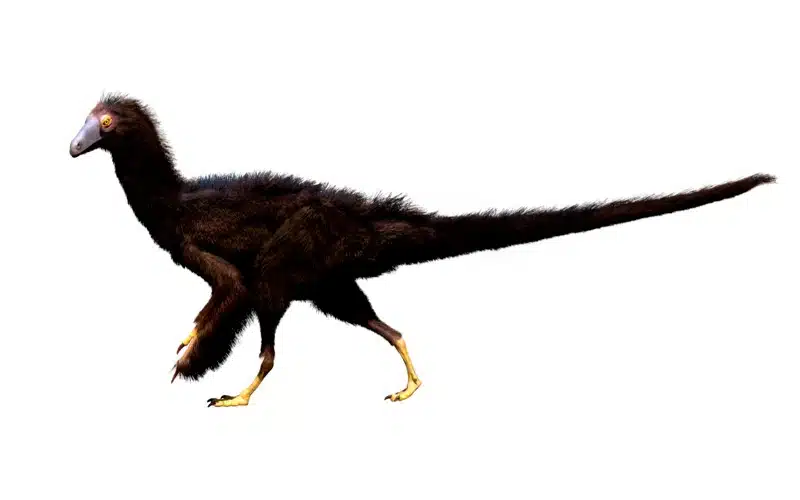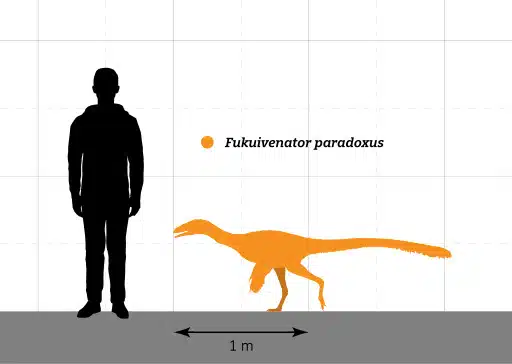Fukuivenator, is a fascinating dinosaur discovered in the Fukui Prefecture of Japan, and dates from Early Cretaceous Period. Its name, meaning “Hunter from Fukui,”, it was discovered in 2007 and first described in 2016. Turns out Fukuivenator might have an omnivorous diet.
Fukuivenator Key Facts
| Keyword | Fact |
|---|---|
| Pronunciation | Foo-koo-ee-ven-ay-tor |
| Meaning of name | Hunter of Fukui Prefecture |
| Group | Theropod |
| Family | Dromaeosaurid |
| Genus | Fukuivenator |
| Type Species | Fukuivenator paradoxus |
| Diet | Omnivorous |
| When it Lived | 127.0 to 115.0 MYA |
| Period | Early Cretaceous |
| Epoch | Aptian |
| Length | 8.2 ft |
| Height | 3.3 ft at the hips |
| Weight | 55.0 pounds |
| Mobility | Moved on two legs |
| First Discovery | 2007 by a team led by Yoichi Azuma |
| Described by | 2016 by Yoichi Azuma, Xu Xing, Masateru Shibata, Soichiro Kawabe, Kazunori Miyata and Takuya Imai |
| Holotype | FPDM-V8461 |
| Location of first find | Kitadani Locality, Fukui Prefecture, Japan |
Fukuivenator Origins, Taxonomy and Timeline
The name Fukuivenator derives from “Fukui,” the Japanese prefecture where it was found, and “venator,” the Latin word for hunter. This nomenclature highlights both its geographical origins and its predatory nature (however, I’ll explain below how its carnivory diet is challenged). The species name “paradoxus” refers to the surprising mix of anatomical features found in this dino.

Taxonomically, Fukuivenator belongs to the Theropoda and is classified within the Maniraptora. The genus Fukuivenator includes the type species Fukuivenator paradoxus, which is the only known species of this genus. This classification places it among agile, bipedal predators closely related to birds.
Fukuivenator lived during the Early Cretaceous Period. Radioisotopic dates were obtained from adjacent rocks and gave a time range from 127 to 115 Ma. This place our dino in the Aptian to Barremian age, according to the updated geological time scale. As Japanese dinosaurs are quite rare compared to other countries, understanding the timeline of Fukuivenator helps contextualize its evolutionary adaptations and its role in the Cretaceous Japanese ecosystems.
Discovery & Fossil Evidence
Fukuivenator was first discovered in 2007 during annual summer quarry works at the Kitadani Locality, on the Sugiyama River in Fukui Prefecture, Honshu Island, Japan. This site is renowned for its rich deposits of Early Cretaceous fossils, providing a wealth of information about the prehistoric life of the region.
The holotype, cataloged as FPDM-V8461, includes a well-preserved skeleton, relatively complete. It includes skull fragments, vertebrae, limb bones (both front and rear), and parts of the pelvis. The degree of preservation allowed paleontologists to reconstruct the physical characteristics and infer the dietary habits of Fukuivenator.

先従隗始, CC0, via Wikimedia Commons
The initial description of Fukuivenator was published in 2016 by Yoichi Azuma, Xu Xing, Masateru Shibata, Soichiro Kawabe, Kazunori Miyata, and Takuya Imai. Since then, no additional significant finds of this genus have been reported, making the holotype specimen an essential reference for studying this unique dinosaur.
An additional study on the osteology of this dino was later published in 2021, led by Hattori and colleagues. With the help of CT-scan analysis, they uncovered several cranial bones that were not observed in the initial study on 2016 (like the parietal bone). The CT-scan and associated 3D work enabled them to produce detailed 3D images of all individual bones, and gave a better understanding of this dino. This would lead to refining the phylogenetic position of Fukuivenator among the maniraptors, as an early-diverging therizinosaur.
Fukuivenator Size and Description
Short description of Fukuivenator
Fukuivenator was a small, agile theropod with a lightweight and streamlined body. The skull was relatively small and equipped with a mix of sharp and flat teeth, indicating a diet that included both animal and plant matter. Its neck was flexible, supporting quick head movements essential for hunting and foraging.
The vertebrae and limb bones of Fukuivenator were robust yet lightweight, providing both strength and agility. The hind limbs were mighty, designed for swift, bipedal locomotion. The forelimbs, although shorter, were well-developed and likely used for grasping and manipulating food. Its long tail served as a counterbalance, enhancing stability during rapid movements. The skin, while not directly evidenced, is presumed to have been scaly, typical of Theropods.
Size and Weight of Type Species
The type species, Fukuivenator paradoxus, measured approximately 8.2 feet in length, making it a relatively small dinosaur. Standing at about 3.3 feet tall at the hips, it had a low center of gravity that facilitated agile movement. This size suggests it was a nimble predator, capable of navigating various terrains with ease.

Weighing around 55.0 pounds, Fukuivenator was lightweight, which contributed to its agility and speed. This moderate weight, combined with its size, made it well-suited for exploiting a diverse range of food sources. The size estimates are based on the well-preserved skeletal fragments, providing a reliable picture of its physical characteristics.
These dimensions reflect a dinosaur that was well-adapted to its ecological niche. Its small size and agility allowed it to exploit various food sources and avoid larger predators, ensuring its survival in the competitive environment of the Early Cretaceous.
The Dinosaur in Detail
Fukuivenator is distinguished by several unique features that highlight its adaptability and evolutionary significance. Its dental structure is particularly notable. Maniraptorian at the time were going through a change in diet, form a full carnivory to a omnivorous feeding habits (and possibly herbivorous, although the herbivorous habits of Alvarezsauridae is challenged by Wang et al., 2024). The initial publication of Fukuivenator mentioned that it represents some sort of intermediate condition, although it is not clear if this dino was omnivorous
The dinosaur’s limb structure is another key feature. The robust hind limbs suggest strong muscles and tendons, enabling powerful strides and rapid movements. The forelimbs, though shorter, were dexterous and likely used for grasping.
Additionally, the vertebrae and tail of Fukuivenator were well-adapted for balance and agility. The long tail acted as a counterbalance, improving stability during quick movements. This anatomical feature, combined with its lightweight skeleton, made Fukuivenator a versatile and agile dinosaur, capable of thriving in diverse environments.
Another cool feature of Fukuivenator is its inner ear. This part of the skull plays an essential role in the earring system of the animal, and you may be able to infer its way of life based on the morphology of the inner ear canals and chambers. In the case of Fukuivenator, the authors mentioned its morphology is somewhat transitional from a theropod to the one found in birds. It doesn’t mean Fukuivenator was flying, but maybe it shared a common evolutionary history with birds (that are also theropod dinosaurs).
Contemporary Dinosaurs
One of the dinosaurs that shared the landscape with Fukuivenator was Fukuiraptor. This theropod, discovered in the same region, was a larger and more robust predator. Fukuiraptor likely occupied a higher tier in the food chain, preying on larger animals. The presence of both Fukuivenator and Fukuiraptor in the same ecosystem suggests a complex predator-prey dynamic, with each species exploiting different ecological niches.
Another dinosaur contemporary was Koshisaurus, a smaller herbivorous (hadrosaur type) dinosaur. Koshisaurus, with its plant-based diet, provided a potential food source for omnivorous predators like Fukuivenator. The coexistence of these two dinosaurs indicates a balanced ecosystem where herbivores and (possible) omnivores interact, influencing each other’s feeding and foraging behaviors.
Also present in this period was Fukuititan, a large sauropod. Fukuititan, with its massive size and herbivorous diet, contributed significantly to the vegetation dynamics of the region. The interactions between Fukuivenator and Fukuititan were likely indirect, with Fukuivenator benefiting from the environmental changes brought about by the large sauropod’s feeding habits. These interactions highlight the intricate web of relationships that defined the Early Cretaceous ecosystems.
Interesting Points about Fukuivenator
- Fukuivenator’s name means “Hunter of Fukui Prefecture,” reflecting its geographical origin and predatory nature.
- It had a unique mix of sharp and flat teeth, indicating a possible omnivorous diet (but this needs to be further supported).
- Discovered in 2007 and described in 2016, it is one of the notable and rare dinosaur finds from the Kitadani locality in Japan.
Fukuivenator in its Natural Habitat
Fukuivenator thrived in the lush and dynamic environments of Early Cretaceous Japan. The climate during this period was generally warm, with distinct wet and dry seasons that influenced the vegetation and water availability. This diverse habitat supported a rich variety of plant life, including ferns, cycads, and conifers, which provided food and cover for numerous dinosaur species.
As an omnivore, Fukuivenator had possibly a versatile diet that would allow it to exploit a range of food sources. It may have fed on small vertebrates, insects, and plant material, using its sharp teeth to catch and consume prey and its flat teeth to process vegetation. This dietary flexibility would have given Fukuivenator an advantage in varying environmental conditions, ensuring it could find sustenance even when specific food sources were scarce.
Fukuivenator’s locomotion was primarily bipedal, supported by its powerful hind limbs, which enabled swift and agile movements. This agility was essential for hunting small prey and evading larger predators. Its forelimbs, though shorter, were likely used for grasping and manipulating food, enhancing its ability to forage effectively. The dinosaur’s long tail provided balance during rapid movements, contributing to its overall agility and stability.
Socially, Fukuivenator may have been solitary or lived in small groups, though definitive evidence of its social behavior is limited. Its keen senses, particularly vision and possibly olfaction, would have been crucial for locating prey and navigating its environment. These adaptations highlight Fukuivenator’s role as a versatile and adaptable dinosaur within its ecosystem.
Frequently Asked Questions
The name Fukuivenator means “Hunter of Fukui Prefecture,” reflecting its
geographical origin and predatory nature.
Fukuivenator lived during the Early Cretaceous Period, approximately 127.0 to 115.0 million years ago.
Fukuivenator was discovered in 2007 by a team of Japanese paleontologists led by Yoichi Azuma at the Kitadani Locality in Fukui Prefecture, Japan.
Fukuivenator was an omnivore, feeding on small vertebrates, insects, and plant
material, as indicated by its mixed dental structure.
Fukuivenator was about 8.2 feet long, 3.3 feet tall at the hips, and weighed around 55.0 pounds.
Fossils of Fukuivenator have been found primarily at the Kitadani Locality in Fukui Prefecture, Japan.
Sources
The information in this article is based on various sources, drawing on scientific research, fossil evidence, and expert analysis. The aim is to provide a comprehensive and accurate overview of Fukuivenator. However, please be aware that our understanding of dinosaurs and their world is constantly evolving as new discoveries are made.
This article was last fact checked: Joey Arboleda, 07-01-2024
Featured Image Credit: Petr Menshikov, CC BY-SA 4.0, via Wikimedia Commons
